| Pages:
1
..
41
42
43
44
45
..
78 |
Bert
Super Administrator
        
Posts: 2821
Registered: 12-3-2004
Member Is Offline
Mood: " I think we are all going to die. I think that love is an illusion. We are flawed, my darling".
|
|
| Quote: | i pulled this out of a old 1860,s book i was reading on google books but i cant remember witch one it was  anyway they are useing sodium nitrate and boracic acid heated together to produce nitric acid . anyway they are useing sodium nitrate and boracic acid heated together to produce nitric acid .
By the patent process of M. Mallet, dried nitrate of soda is decomposed by dried or monohydrated boracic acid, by heating the two together. The
products are liquid nitric acid, which distils over, and biborate of soda (borax), which remains in the retort.
|
Now THAT is of some interest... As in USA, sodium nitrate is available for meat curing, fertilizer and other uses OTC, with boric acid (boracic acid
is an old fasioned name) being available at any hardware store and/or drug store.
One might assume that using anhydrous or nearly so chemicals could produce a fuming, possibly darn near anhdrous nitric acid?
Checking heats of fusion, and solubility of the residual borax left in one's distilling flask...
(Edit)
Boric acid, MP 179 C.
Sodium nitrate, MP 308 C.
Borax decahydrate would be the easily soluble form of borax, apparently anhydrous borax (as this residue would be) is only very slowly soluble in
comparison. But probably still do-able, if one was not in a great hurry to use the retort again.
One could assume the reaction to begin at the MP of boric acid? A shot bath or sand bath for heating and ordinary pyrex glassware could do for the
aparatus.
One potential issue with the use of glass aparatus might be the well known fluxing action of borax in a glass melt?
This calls for a quick experiment.
[Edited on 25-8-2016 by Bert]
[Edited on 25-8-2016 by Bert]
Rapopart’s Rules for critical commentary:
1. Attempt to re-express your target’s position so clearly, vividly and fairly that your target says: “Thanks, I wish I’d thought of putting it
that way.”
2. List any points of agreement (especially if they are not matters of general or widespread agreement).
3. Mention anything you have learned from your target.
4. Only then are you permitted to say so much as a word of rebuttal or criticism.
Anatol Rapoport was a Russian-born American mathematical psychologist (1911-2007).
|
|
|
nux vomica
Hazard to Others
  
Posts: 267
Registered: 18-7-2013
Member Is Offline
Mood: No Mood
|
|
Quote: Originally posted by Bert  |
| Quote: | i pulled this out of a old 1860,s book i was reading on google books but i cant remember witch one it was :( anyway they are useing sodium nitrate
and boracic acid heated together to produce nitric acid .
By the patent process of M. Mallet, dried nitrate of soda is decomposed by dried or monohydrated boracic acid, by heating the two together. The
products are liquid nitric acid, which distils over, and biborate of soda (borax), which remains in the retort.
|
Now THAT is of some interest... As in USA, sodium nitrate is available for meat curing, fertilizer and other uses OTC, with boric acid (boracic acid
is an old fasioned name) being available at any hardware store and/or drug store.
One might assume that using anhydrous or nearly so chemicals could produce a fuming, possibly darn near anhdrous nitric acid?
Checking heats of fusion, and solubility of the residual borax left in one's distilling flask...
(Edit)
Boric acid, MP 179 C.
Sodium nitrate, MP 308 C.
Borax decahydrate would be the easily soluble form of borax, apparently anhydrous borax (as this residue would be) is only very slowly soluble in
comparison. But probably still do-able, if one was not in a great hurry to use the retort again.
One could assume the reaction to begin at the MP of boric acid? A shot bath or sand bath for heating and ordinary pyrex glassware could do for the
aparatus.
One potential issue with the use of glass aparatus might be the well known fluxing action of borax in a glass melt?
This calls for a quick experiment.
[Edited on 25-8-2016 by Bert]
[Edited on 25-8-2016 by Bert] |
Hmm i have boric acid and sodium nitrate at home i wonder if you mix the reactants in equal molar amounts or need a excess of one, as usual these old
science books are a bit vague on detail..
They also mention earthen ware retorts and cast iron retorts in other parts of the book if i remember right .
I might mix and heat some of the chems up in a test tube to see if something happens and what the borax does to the glass tube.
(Edit)
I had a small scale test of heating boric acid and sodium nitrate together in a test tube there was a vapor condencing on the test tube walls and also
red fumes comeing off when i heated the tube strongly, ph test paper held in the vapors went red as well so acid fumes are being generated.
I looked for the book with the text i copyed but i havent found it yet but i did find some informaton from a book that was published in 1830 its
called the chemistry of the arts by Arthur t Porter and this is what the book says about aqua fortis .
Aqua Fortis. To obtain the common nitric acid called aquafortis, equal parts of well purified nitre and copperas, or green vitriol, are taken. The
nitre is dried, and the vitriol is calcined to red ness. These two substances are well mixed together. The mixture is then put into an earthen retort,
or an iron pot, with a stone-ware head, of such a size that they may be but half full. The retort, if used, is set in a reverberating furnace, and in
either case, a large glass receiver, having a small hole in its body, stopped with a little lute, or a safety-pipe, is ap plied. This receiver is
luted to the retort with the fat lute, and the joint covered with a slip of canvass, smeared with lute made of quicklime and the white of an egg. The
vessels are heated gradually; the receiver is soon filled with very dense red vapours. In order that the redundant vapours may be let out, the small
hole in the receiver must be opened from time to time. Towards the end of the operation, the fire must be raised so that the ves sel is made red. When
it is found, even if the retort be red hot, that nothing more comes over, the vessels are left to cool, and the receiver is unluted, and, without
delay, the liquor it contains is poured into a bottle. This liquor, being nitrous acid, is of a reddish-yellow colour, smokes exceedingly, and the
bottle containing it is constantly filled with red fumes, like those observed in the distillation. By this process a very strong and smoking spirit of
nitre is obtained. If the precautions of drying the nitre, and calcining the vitriol, be neglected, the acid that comes over, greedily at tracting the
water contained in these salts, will be very aqueous, will not smoke, and will be almost colourless with a very slight tinge of yellow, and is sold by
the name of single aqua fortis. The fumes of highly concentrated nitrous acid, such as that obtained by the above process, are corrosive, and very
dangerous to the lungs.
[Edited on 26-8-2016 by nux vomica]
|
|
|
nux vomica
Hazard to Others
  
Posts: 267
Registered: 18-7-2013
Member Is Offline
Mood: No Mood
|
|
I just gave the synthesis a go but on a small scale i used equal molar amounts of reactents..
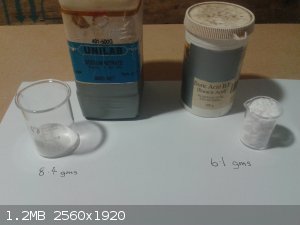
Then ran my new heating mantle flat out the first droplets formed in 10 minutes .
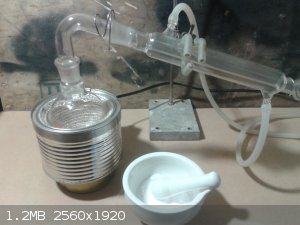 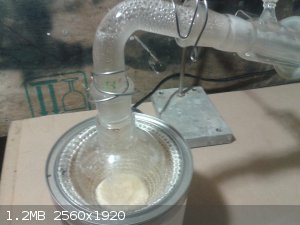 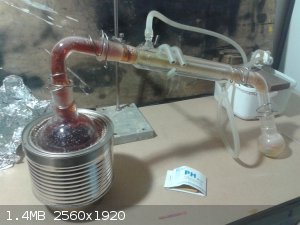
After reaction was over.
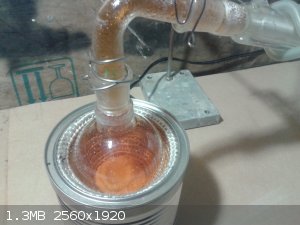 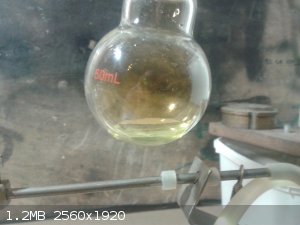
The final result was just over 3mls of fuming nitric acid there was more droplets in the condencer but they were too hard to recover.
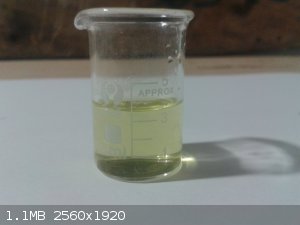
The acid in a beaker reacting with copper.
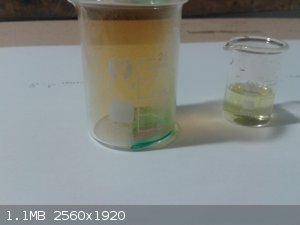
It looks like this method works but not wanting to heat my flask with a flame i dont know if yields would be higher with more heat.
Cheers nux
[Edited on 27-8-2016 by nux vomica]
|
|
|
NeonPulse
Hazard to Others
  
Posts: 417
Registered: 29-6-2013
Location: The other end of the internet.
Member Is Offline
Mood: Isolated from Reality! For Real this time....
|
|
Very interesting experiment there nux. Did you measure the density of the resulting liquid? Just curious to see the estimated concentration. Heating
with a flame would probably not work the greatest due to decomposing the acid but very nice result of a method I haven't seen before.
|
|
|
Laboratory of Liptakov
International Hazard
    
Posts: 1333
Registered: 2-9-2014
Location: Technion Haifa
Member Is Offline
Mood: cool.gif
|
|
Perfectly photos. Only 3 cm 3 HNO3 ? Thus 4 grams? From 8,4g KNO3 + 6,1 Boric a., I mean, a good attempt. ...
Without vacuum apparatus. Good result. Very easy method. Dr.
Development of primarily - secondary substances CHP (2015) Lithex (2022) Brightelite (2023) Nitrocelite (2024)
|
|
|
nux vomica
Hazard to Others
  
Posts: 267
Registered: 18-7-2013
Member Is Offline
Mood: No Mood
|
|
Quote: Originally posted by NeonPulse  | | Very interesting experiment there nux. Did you measure the density of the resulting liquid? Just curious to see the estimated concentration. Heating
with a flame would probably not work the greatest due to decomposing the acid but very nice result of a method I haven't seen before.
|
I didnt measure the acids density as i was a bit cocky and thought i would nitrate some homemade Pentaerythritol i made recently.
I got a small amount of petn when i diluted the mix at the end but i think the acid wont nitrate properly without sulfuric acid by the looks of
things.
It also slightly eroded the bottom of the flask so i dont want to damage the flask anymore than it is so i won't try that reaction again.
|
|
|
nux vomica
Hazard to Others
  
Posts: 267
Registered: 18-7-2013
Member Is Offline
Mood: No Mood
|
|
Quote: Originally posted by Laboratory of Liptakov  | Perfectly photos. Only 3 cm 3 HNO3 ? Thus 4 grams? From 8,4g KNO3 + 6,1 Boric a., I mean, a good attempt. ...
Without vacuum apparatus. Good result. Very easy method. Dr. |
Yes not a great result but you can only give it a go. 
|
|
|
PHILOU Zrealone
International Hazard
    
Posts: 2893
Registered: 20-5-2002
Location: Brussel
Member Is Offline
Mood: Bis-diazo-dinitro-hydroquinonic
|
|
Quote: Originally posted by nux vomica  | Quote: Originally posted by NeonPulse  | | Very interesting experiment there nux. Did you measure the density of the resulting liquid? Just curious to see the estimated concentration. Heating
with a flame would probably not work the greatest due to decomposing the acid but very nice result of a method I haven't seen before.
|
I didnt measure the acids density as i was a bit cocky and thought i would nitrate some homemade Pentaerythritol i made recently.
I got a small amount of petn when i diluted the mix at the end but i think the acid wont nitrate properly without sulfuric acid by the looks of
things.
It also slightly eroded the bottom of the flask so i dont want to damage the flask anymore than it is so i won't try that reaction again.
|
@ Nux Vomica, very nice OTC HNO3!
HNO3 for the crowd!
Strange that it eroded your flask...especially if you didn't overheated into a flame.
Normally NaNO3, HNO3 are inoffensive towards glass.
Maybe B(OH)3 (H3BO3) or borax are somehow integrating into the glass...borosilicate glass is known...but without strong heating (red heat) it seems
strange.
For the rest if it is really a problem, one could use aluminium or iron since those are inert/passivated towards strong HNO3...but for iron, avoid
contact with other metals (like copper) what may depassivate it instantly.
Adding a little water into the reactor may increase the yield of HNO3 recovery (of course of lower concentration) but for some applications very
concentrated is not needed (like amine nitrate salts).
Increasing the amount of reactants will also increase the yield since a lot of drops are stuck into the retort.
Increasing the heat or vaccuum or the cold trap would also increase the yield.
Just two ideas! H3BO3 can be dehydrated to B2O3 above 300°C.
1°)So maybe that mixing intimately NaNO3 and B2O3 then subjected to strong heat and cold trapping (eventually under vaccuum) may lead directly to
anhydrous nitric acid anhydride (N2O5)...
NaNO3 + B2O3 --> Na2B4O7 (or NaxByOz) + N2O5
2°)Alternatively if first doesn't work, at least:
B2O3 + HNO3 -heat-reflux below200°C-> N2O5 + H3BO3(s)
or
HNO3 (dil) + B2O3 -heat reflux-> HNO3 (conc) + H3BO3(s)
It should be a way to increase concentration maybe up to the anhydride...
H3BO3 should be insoluble crystaline into HNO3 and thus easily separated by filtration or decantation/pipeting!
[Edited on 28-8-2016 by PHILOU Zrealone]
PH Z (PHILOU Zrealone)
"Physic is all what never works; Chemistry is all what stinks and explodes!"-"Life that deadly disease, sexually transmitted."(W.Allen)
|
|
|
PHILOU Zrealone
International Hazard
    
Posts: 2893
Registered: 20-5-2002
Location: Brussel
Member Is Offline
Mood: Bis-diazo-dinitro-hydroquinonic
|
|
Quote: Originally posted by Laboratory of Liptakov  | Perfectly photos. Only 3 cm 3 HNO3 ? Thus 4 grams? From 8,4g KNO3 + 6,1 Boric a., I mean, a good attempt. ...
Without vacuum apparatus. Good result. Very easy method. Dr. |
That is not bad given the low quantity of material and maybe not optimum stoechiometry.
Theorically one could get 5,3g HNO3 from 8,4g KNO3 so 4g is nearly 80%...
PH Z (PHILOU Zrealone)
"Physic is all what never works; Chemistry is all what stinks and explodes!"-"Life that deadly disease, sexually transmitted."(W.Allen)
|
|
|
PHILOU Zrealone
International Hazard
    
Posts: 2893
Registered: 20-5-2002
Location: Brussel
Member Is Offline
Mood: Bis-diazo-dinitro-hydroquinonic
|
|
I have done the maths and worked out the stoechiometry:
2 NaNO3 + 4 H3BO3 --> Na2B4O7 + 2 HNO3 + 5 H2O
MM NaNO3 = 85
MM H3BO3 = 62,8
MM Na2B4O7 = 201,2
MM HNO3 = 63
MM H2O = 18
So from 170 gr dry NaNO3 (sodium nitrate) mixed with 251,2 gr dry H3BO3 (boric acid); one should get:
201,2 gr of Na2B4O7 (borax)
126 gr of HNO3 (nitric acid)
90 gr of H2O (water)
Since the water and the nitric acid will distillate under the process conditions (over 450°C borax initially decahydrated, becomes anhydrous), one
should get 216 gr of 58,33% HNO3 solution.
Thus from 100 gr of initial mix (40.36% Na nitrate and 59.64% boric acid) one gets theorically 51.28 gr of nitric acid of 58.33%
concentration.
From this information it is obvious that the trial of Nux Vomica misses quite some H3BO3 to get
optimum yield...for 8,4 gr Na nitrate he should have used 12,41 gr boric acid instead of 6,1 gr...a double dose.
RECYCLING:
The beauty of this OTC process is that the boric acid can be recycled from borax and OTC-ish HCl (chlorhydric acid) or H2SO4
(sulfuric acid).
Na2B4O7+ H2SO4 + 5 H2O ----> 4 H3BO3 +
Na2SO4
Na2B4O7+ 2 HCl + 5 H2O ----> 4 H3BO3 + 2 NaCl
[Edited on 28-8-2016 by PHILOU Zrealone]
PH Z (PHILOU Zrealone)
"Physic is all what never works; Chemistry is all what stinks and explodes!"-"Life that deadly disease, sexually transmitted."(W.Allen)
|
|
|
nux vomica
Hazard to Others
  
Posts: 267
Registered: 18-7-2013
Member Is Offline
Mood: No Mood
|
|
Quote: Originally posted by PHILOU Zrealone  | I have done the maths and worked out the stoechiometry:
2 NaNO3 + 4 H3BO3 --> Na2B4O7 + 2 HNO3 + 5 H2O
MM NaNO3 = 85
MM H3BO3 = 62,8
MM Na2B4O7 = 201,2
MM HNO3 = 63
MM H2O = 18
So from 170 gr dry NaNO3 (sodium nitrate) mixed with 251,2 gr dry H3BO3 (boric acid); one should get:
201,2 gr of Na2B4O7 (borax)
126 gr of HNO3 (nitric acid)
90 gr of H2O (water)
Since the water and the nitric acid will distillate under the process conditions (over 450°C borax initially decahydrated, becomes anhydrous), one
should get 216 gr of 58,33% HNO3 solution.
Thus from 100 gr of initial mix (40.36% Na nitrate and 59.64% boric acid) one gets theorically 51.28 gr of nitric acid of 58.33%
concentration.
From this information it is obvious that the trial of Nux Vomica misses quite some H3BO3 to get
optimum yield...for 8,4 gr Na nitrate he should have used 12,41 gr boric acid instead of 6,1 gr...a double dose.
RECYCLING:
The beauty of this OTC process is that the boric acid can be recycled from borax and OTC-ish HCl (chlorhydric acid) or H2SO4
(sulfuric acid).
Na2B4O7+ H2SO4 + 5 H2O ----> 4 H3BO3 +
Na2SO4
Na2B4O7+ 2 HCl + 5 H2O ----> 4 H3BO3 + 2 NaCl
[Edited on 28-8-2016 by PHILOU Zrealone] |
Thanks for the maths bit PHILOU Zrelone im more of a nuts and bolts type of person i started to try and work it out and couldent get it to balance.
My instinct was to go with twice as much Boric acid but i decided to keep them equal instead.
With your info i might try a larger reaction to get more acid to measure its density when ive a free hour or so.
Nux.
|
|
|
Bert
Super Administrator
        
Posts: 2821
Registered: 12-3-2004
Member Is Offline
Mood: " I think we are all going to die. I think that love is an illusion. We are flawed, my darling".
|
|
| Quote: | | Since the water and the nitric acid will distillate under the process conditions (over 450°C borax initially decahydrated, becomes anhydrous), one
should get 216 gr of 58,33% HNO3 solution |
I wonder, with careful process control, keeping the heat to just that required to melt the boric acid and drive the reaction, could the borax formed
serve to at least somewhat dehydrate the acid... The questions being, what temperature is REQUIRED for the reaction to proceed, and at what
temperatures does borax hold how many molecules of water of crystalization?
Nice start there, it is good to know that fairly strong nitric acid is available to those without access to OTC sulfuric acid. No place I know of
controls sale of boric acid, the least objectionable of roach poisons.
Rapopart’s Rules for critical commentary:
1. Attempt to re-express your target’s position so clearly, vividly and fairly that your target says: “Thanks, I wish I’d thought of putting it
that way.”
2. List any points of agreement (especially if they are not matters of general or widespread agreement).
3. Mention anything you have learned from your target.
4. Only then are you permitted to say so much as a word of rebuttal or criticism.
Anatol Rapoport was a Russian-born American mathematical psychologist (1911-2007).
|
|
|
James Ikanov
Hazard to Self
 
Posts: 81
Registered: 12-7-2015
Location: Alaska
Member Is Offline
Mood: Zen
|
|
Would it be plausible to use a similar method to produce perchloric acid?
I'm not sure about whether such a thing could be advised, I'm simply curious if it's plausible.
“To do good work one must eat well, be well housed, have one's fling from time to time, smoke one's pipe, and drink one's coffee in peace” -
Vincent Van Gogh
|
|
|
PHILOU Zrealone
International Hazard
    
Posts: 2893
Registered: 20-5-2002
Location: Brussel
Member Is Offline
Mood: Bis-diazo-dinitro-hydroquinonic
|
|
Quote: Originally posted by James Ikanov  | Would it be plausible to use a similar method to produce perchloric acid?
I'm not sure about whether such a thing could be advised, I'm simply curious if it's plausible. |
Good question.
In principle, I see nothing against it since HClO4/H2O is also distillable...sole difference between HClO4 and HNO3 is the acidity (HClO4 is even more
acidic than HNO3 itself much more acidic than H3BO3).
Of course here in no way should the B2O3 / NaClO4 be attempted...the putative anhydrous HClO4 and Cl2O7 being heat sensitive explosives.
PH Z (PHILOU Zrealone)
"Physic is all what never works; Chemistry is all what stinks and explodes!"-"Life that deadly disease, sexually transmitted."(W.Allen)
|
|
|
Microtek
National Hazard
   
Posts: 827
Registered: 23-9-2002
Member Is Offline
Mood: No Mood
|
|
I could see the much higher boiling point of HClO4 causing some trouble, but maybe with a sufficient vacuum...
|
|
|
PHILOU Zrealone
International Hazard
    
Posts: 2893
Registered: 20-5-2002
Location: Brussel
Member Is Offline
Mood: Bis-diazo-dinitro-hydroquinonic
|
|
I have done the maths and worked out the stoechiometry:
2 NaClO4 + 4 H3BO3 --> Na2B4O7 + 2 HClO4 + 5 H2O
MM NaClO4 = 122,5
MM H3BO3 = 62,8
MM Na2B4O7 = 201,2
MM HClO4 = 100,5
MM H2O = 18
So from 245 gr dry NaClO4 (sodium perchlorate) mixed with 251,2 gr dry H3BO3 (boric acid); one should get:
201,2 gr of Na2B4O7 (borax)
201 gr of HClO4 (perchloric acid)
90 gr of H2O (water)
Since the water and the perchloric acid will distillate under the process conditions (over 450°C borax initially decahydrated, becomes anhydrous),
one should get 291 gr of 69,1% HClO4 solution. (Boiling point should be arround 200-203°C vs 120°C for the
HNO3)
Thus from 100 gr of initial mix (49,38% Na perchlorate and 50,62% boric acid) one gets theorically 58,65 gr of perchloric acid of 69,1%
concentration.
RECYCLING:
The beauty of this OTC process is that the boric acid can be recycled from borax and OTC-ish HCl (chlorhydric acid) or H2SO4
(sulfuric acid).
Na2B4O7+ H2SO4 + 5 H2O ----> 4 H3BO3 +
Na2SO4
Na2B4O7+ 2 HCl + 5 H2O ----> 4 H3BO3 + 2 NaCl
[Edited on 30-8-2016 by PHILOU Zrealone]
PH Z (PHILOU Zrealone)
"Physic is all what never works; Chemistry is all what stinks and explodes!"-"Life that deadly disease, sexually transmitted."(W.Allen)
|
|
|
Tricka90
Hazard to Self
 
Posts: 52
Registered: 14-8-2016
Member Is Offline
Mood: No Mood
|
|
Short question: Sensitivity when wet
Can primary as well as secondary explosives (such as silver acetilyde or picric acid as an example) be considered completely unsensitive when wet?
Of course friction and impact sensitivity would decrease due to lower friction between grains and damp impact provided by water. Flame and heat
sensitivity would also decrease because of water heating inertia. But do you think solid explosives are really 100% stable and just can't detonate
under water? Do you have any direct experience?
[Edited on 31-8-2016 by Tricka90]
|
|
|
Lotilko
Hazard to Self
 
Posts: 76
Registered: 9-6-2016
Member Is Offline
|
|
Well, sensitive secondaries like PETN are very stable, however for some primaries like organic peroxides and nitrogen halides water won't really help.
Water makes the explosives more resistant to physical disturbance. But when there are unstable bonds in the molecule it's a whole different story.
|
|
|
Maker
Harmless

Posts: 46
Registered: 1-11-2015
Member Is Offline
Mood: No Mood
|
|
Why is potassium nitrate used as an oxidizer in pyrotechnic compositions when sodium nitrate has more nitrate ions per gram?
|
|
|
Metacelsus
International Hazard
    
Posts: 2531
Registered: 26-12-2012
Location: Boston, MA
Member Is Offline
Mood: Double, double, toil and trouble
|
|
Sodium will make a yellow color, obscuring any other coloring agents. Also, it's a lot more hygroscopic than potassium nitrate, so it's bad for
storage purposes.
|
|
|
kratomiter
Hazard to Others
  
Posts: 106
Registered: 30-9-2012
Member Is Offline
Mood: No Mood
|
|
Quote: Originally posted by Tricka90  | Can primary as well as secondary explosives (such as silver acetilyde or picric acid as an example) be considered completely unsensitive when wet?
Of course friction and impact sensitivity would decrease due to lower friction between grains and damp impact provided by water. Flame and heat
sensitivity would also decrease because of water heating inertia. But do you think solid explosives are really 100% stable and just can't detonate
under water? Do you have any direct experience?
[Edited on 31-8-2016 by Tricka90] |
Some sensitive secondary explosive like picric acid or DNPH when wet are considered enough unsensitive that no special cautions are considered for
transport and storage (I'm talking about quantities lower than 1 kg, AFAIK).
But I have no idea about primary explosives.
One question: I'm looking for a inner coating for copper tubes. I use it for making detonators, but copper can be form dangerous salts with some
explosives and make them more sensitive. Is there a cheap way to make an inert coating? Maybe cyanocrilate?
|
|
|
MineMan
National Hazard
   
Posts: 996
Registered: 29-3-2015
Member Is Offline
Mood: No Mood
|
|
Why copper, why not just switch to Al or graphite??
|
|
|
Maker
Harmless

Posts: 46
Registered: 1-11-2015
Member Is Offline
Mood: No Mood
|
|
Quote: Originally posted by kratomiter  | Quote: Originally posted by Tricka90  | Can primary as well as secondary explosives (such as silver acetilyde or picric acid as an example) be considered completely unsensitive when wet?
Of course friction and impact sensitivity would decrease due to lower friction between grains and damp impact provided by water. Flame and heat
sensitivity would also decrease because of water heating inertia. But do you think solid explosives are really 100% stable and just can't detonate
under water? Do you have any direct experience?
[Edited on 31-8-2016 by Tricka90] |
Some sensitive secondary explosive like picric acid or DNPH when wet are considered enough unsensitive that no special cautions are considered for
transport and storage (I'm talking about quantities lower than 1 kg, AFAIK).
But I have no idea about primary explosives.
One question: I'm looking for a inner coating for copper tubes. I use it for making detonators, but copper can be form dangerous salts with some
explosives and make them more sensitive. Is there a cheap way to make an inert coating? Maybe cyanocrilate? |
Why not just use a glass tube?
[Edited on 2-9-2016 by Maker]
|
|
|
Maker
Harmless

Posts: 46
Registered: 1-11-2015
Member Is Offline
Mood: No Mood
|
|
How do you decide what length vigreux column to use for fractional distillation? Is it a case of the bigger the better or is there more to it than
that?
|
|
|
aga
Forum Drunkard
    
Posts: 7030
Registered: 25-3-2014
Member Is Offline
|
|
I got two vigreux columns, 300mm-ish.
Not enough headroom in the hood to put one on top of the other, so it's always 300mm-ish.
If you calculate (based on theoretical plates etc) a 40m tall column, it won't work.
Basically you got to go with what you have.
If it does not resolve your B.P.s sufficiently well, you got to distill it again.
Maybe many times.
[Edited on 2-9-2016 by aga]
|
|
|
| Pages:
1
..
41
42
43
44
45
..
78 |